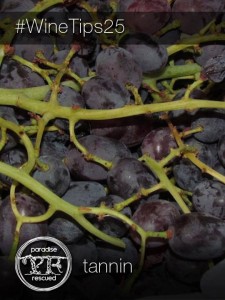Tannin is one of the most common words used in describing a wine. But what is it, what does it taste like and where does it come from?
Tannin is a natural occurring part of many drinks and foods, including wine. One of the best examples of tannin and its taste can be found when you drink strong black tea! Tannin is a natural part of all wood containing plants and when processed or fermented, these tannins are extracted into the juice. In wine grapes, the tannins can be found in the grape skins, seeds and stems. Red wines typically have much higher levels of tannin than white wines as they are made through the direct contact of the juice and all its grape components over a long period of time.
A high tannic wine often has greater “in vat” contact or maceration between the juice, skins, seeds and stalks. Different red wine grape varieties produce different levels and styles of tannin. For instance Cabernet Sauvignon and Shiraz / Syrah are higher tannic wines compared to say Pinot Noir or Merlot. Grape ripeness can also impact the level of tannin. The less ripe the fruit, the harsher the tannins can be, requiring a different winemaking approach. Winemakers can also influence the desired tannin levels by de-stemming the grapes prior to crushing and fermenting and / or controlling the amount of time that the wine spends in contact with the skins in the vat.
A further contributor to the tannin taste in wine can also be the oak barrel in which the wine has been fermented or matured, where the tannin is slowly extracted from the wood over a longer period of time.
Describing the taste of tannin is difficult. Young red wines are often characterized by the taste of tannin. The most obvious clue of a tannic wine is a very dry astringent taste across the tongue after you have finished your sip. However tannins change and “soften” with ageing over time and often find their way into the sediment in the bottom of the bottle – another good reason to decant older wines![/fusion_builder_column][/fusion_builder_row][/fusion_builder_container]
